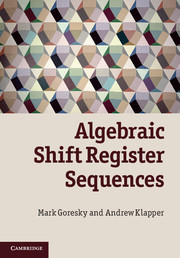Book contents
- Frontmatter
- Contents
- List of figures
- List of tables
- Acknowledgements
- 1 Introduction
- PART I ALGEBRAICALLY DEFINED SEQUENCES
- PART II PSEUDO-RANDOM AND PSEUDO-NOISE SEQUENCES
- 8 Measures of pseudo-randomness
- 9 Shift and add sequences
- 10 m-sequences
- 11 Related sequences and their correlations
- 12 Maximal period function field sequences
- 13 Maximal period FCSR sequences
- 14 Maximal period d-FCSR sequences
- PART III REGISTER SYNTHESIS AND SECURITY MEASURES
- PART IV ALGEBRAIC BACKGROUND
- Bibliography
- Index
8 - Measures of pseudo-randomness
from PART II - PSEUDO-RANDOM AND PSEUDO-NOISE SEQUENCES
Published online by Cambridge University Press: 05 February 2012
- Frontmatter
- Contents
- List of figures
- List of tables
- Acknowledgements
- 1 Introduction
- PART I ALGEBRAICALLY DEFINED SEQUENCES
- PART II PSEUDO-RANDOM AND PSEUDO-NOISE SEQUENCES
- 8 Measures of pseudo-randomness
- 9 Shift and add sequences
- 10 m-sequences
- 11 Related sequences and their correlations
- 12 Maximal period function field sequences
- 13 Maximal period FCSR sequences
- 14 Maximal period d-FCSR sequences
- PART III REGISTER SYNTHESIS AND SECURITY MEASURES
- PART IV ALGEBRAIC BACKGROUND
- Bibliography
- Index
Summary
Golomb's randomness postulates. In 1967 Golomb proposed three desirable criteria that one might ask of a binary pseudo-random sequence a [61, 62].
It should be balanced,
it should have the run property (Section 8.2.2), and
it should have an ideal autocorrelation function.
These concepts are described below. Since then, new applications have created an enormous demand for pseudo-random sequences that exhibit additional, more sophisticated randomness properties. Some of these requirements are known to be incompatible with others. Currently, for any given application, one generally draws up a list of required randomness properties and then goes about trying to find or to design a pseudo-random sequence that meets these requirements. Although Golomb's list looks rather minimal by today's standards, it is an amazing fact that there are still only a handful of known techniques for constructing sequences with all three of these properties. In this section we will describe some of the most common measures of randomness.
Why pseudo-random?
Random numbers (in one sense or another) have applications in computer simulation, Monte Carlo integration, cryptography, randomized computation, radar ranging, and other areas. In each case we need a sequence of numbers (or of bits) that “appears” to be “random”, yet is repeatable. Of course these are contradictory requirements. If we know the sequence beforehand, then it is not random.
Information
- Type
- Chapter
- Information
- Algebraic Shift Register Sequences , pp. 167 - 190Publisher: Cambridge University PressPrint publication year: 2012
